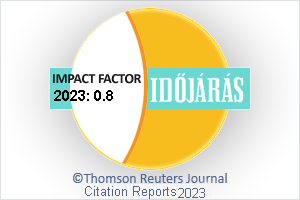Időjárás - Quarterly Journal of the Hungarian Meteorological Service (OMSZ)
Vol. 129, No. 3 * Pages 241–372 * July - September 2025
 |
|
 download [pdf: 2311 KB]
download [pdf: 2311 KB]
Homogenized and gridded daily surface air pressure data series in Hungary from 1901 to 2023
Olivér Szentes, Rita Pongrácz, and Mónika Lakatos
DOI:10.28974/idojaras.2025.3.1 (pp. 241–263)
Olivér Szentes, Rita Pongrácz, and Mónika Lakatos
DOI:10.28974/idojaras.2025.3.1 (pp. 241–263)
Characteristics of the September-December Teleconnection (SDT) in the current Atlantic Multidecadal Oscillation (AMO) phase
György Babolcsai and Tamás Hirsch
DOI:10.28974/idojaras.2025.3.2 (pp. 265–278)
György Babolcsai and Tamás Hirsch
DOI:10.28974/idojaras.2025.3.2 (pp. 265–278)
Cold-air pool development and covariance analysis of the measured meteorological parameters in the Mohos sinkhole, Bükk Plateau, Hungary
András Dobos, Réka Farkas, and Endre Dobos
DOI:10.28974/idojaras.2025.3.3 (pp. 279–306)
András Dobos, Réka Farkas, and Endre Dobos
DOI:10.28974/idojaras.2025.3.3 (pp. 279–306)
Bioclimate conditions in the Mura-Drava-Danube Transboundary Biosphere Reserve – case study from Serbia
Jelena Dunjić, Vladimir Stojanović, Dragan Milošević, Milana Pantelić, Sanja Obradović, and Milica Vasić
DOI:10.28974/idojaras.2025.3.4 (pp. 307–337)
Jelena Dunjić, Vladimir Stojanović, Dragan Milošević, Milana Pantelić, Sanja Obradović, and Milica Vasić
DOI:10.28974/idojaras.2025.3.4 (pp. 307–337)
K-means clustering of precipitation in the Black Sea Region, Türkiye
Aslı Ulke Keskin, Gurkan Kır, and Utku Zeybekoglu
DOI:10.28974/idojaras.2025.3.5 (pp. 339–355)
Aslı Ulke Keskin, Gurkan Kır, and Utku Zeybekoglu
DOI:10.28974/idojaras.2025.3.5 (pp. 339–355)
Evaluation of drought in Bosnia and Herzegovina during the period 1956 –2022
Dragan Papić
DOI:10.28974/idojaras.2025.3.6 (pp. 357–372)
Dragan Papić
DOI:10.28974/idojaras.2025.3.6 (pp. 357–372)
IDŐJÁRÁS - Quarterly Journal

Az IDŐJÁRÁS a HungaroMet Nonprofit Zrt. negyedévenként megjelenő angol nyelvű folyóirata
Megrendelhető a journal.idojaras@met.hu címen.
A szerzőknek szánt útmutató itt olvasható.
Megrendelhető a journal.idojaras@met.hu címen.
A szerzőknek szánt útmutató itt olvasható.









